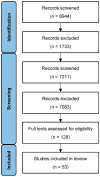The Role of Proximal Femoral Osteotomy for the Treatment of Avascular Necrosis: A Systematic Review of Clinical and Patient-Reported Outcomes
- PMID: 40807211
- PMCID: PMC12347876
- DOI: 10.3390/jcm14155592
The Role of Proximal Femoral Osteotomy for the Treatment of Avascular Necrosis: A Systematic Review of Clinical and Patient-Reported Outcomes
Abstract
Background/Objectives: Avascular necrosis of the femoral head is a debilitating condition that, if left untreated, leads to progressive arthritis necessitating total hip replacement (THR). In the younger adult population, there is a drive towards joint-preserving procedures, particularly where alternative techniques such as core decompression or vascularised bone grafting are anticipated to fail. Proximal femoral osteotomy is a technique that aims to remove the necrotic segment from the weight bearing area. The presented review aims to examine the efficacy of this technique in the management of avascular necrosis of the femoral head, reporting both rates of conversion to total hip replacement and patient reported outcomes. Methods: This systematic review was conducted according to PRISMA guidelines. A search was conducted of PubMed, Ovid Medline, EMBASE, and the Cochrane Library using pre-defined search terms. Data were extracted, and descriptive data presented. Quality of each study was assessed using the NIH quality assessment tool for case series studies. Results: Fifty-three studies with data for 2686 osteotomies are presented. Progression of radiological arthrosis was present in 40% of cases, with 20.3% of patients having undergone conversion to THR at a mean of 75.4 months (range 20-132 months). Patient-reported outcome measures were recorded in 1416 patients, of which the Harris Hip Score was the most commonly utilised. This score improved from a mean of 58.3 to 84.4 at a mean follow-up of 102 months. Conclusions: Osteotomy represented a valid head-preserving technique in the armamentarium against avascular necrosis of the femoral head, with conversion to THR required in 20.3% of patients at 7 years. In those patients who did not require THR, PROMS were similar to the arthroplasty population.
Keywords: avascular necrosis; femoral head; osteonecrosis; osteotomy; total hip replacement.
Conflict of interest statement
The authors declare no conflicts of interest. Paul L Rodham, Vasileios P Giannoudis and Peter V Giannoudis are supported in part by the National Institute for Health and Care Research (NIHR), Leeds Biomedical Research Centre (BRC) (NIHR203331). The views expressed are those of the author(s) and not necessarily those of the NHS, the NIHR, or the Department of Health and Social Care.
Figures




Similar articles
-
Total hip replacement and surface replacement for the treatment of pain and disability resulting from end-stage arthritis of the hip (review of technology appraisal guidance 2 and 44): systematic review and economic evaluation.Health Technol Assess. 2015 Jan;19(10):1-668, vii-viii. doi: 10.3310/hta19100. Health Technol Assess. 2015. PMID: 25634033 Free PMC article.
-
Prescription of Controlled Substances: Benefits and Risks.2025 Jul 6. In: StatPearls [Internet]. Treasure Island (FL): StatPearls Publishing; 2025 Jan–. 2025 Jul 6. In: StatPearls [Internet]. Treasure Island (FL): StatPearls Publishing; 2025 Jan–. PMID: 30726003 Free Books & Documents.
-
Does Flexion Varus Osteotomy Improve Radiographic Findings Compared With Patients Treated in a Brace for Late-onset Legg-Calvé-Perthes Disease?Clin Orthop Relat Res. 2023 Apr 1;481(4):808-819. doi: 10.1097/CORR.0000000000002450. Epub 2022 Nov 6. Clin Orthop Relat Res. 2023. PMID: 36374570 Free PMC article.
-
What Is the Cumulative Incidence of Femoral Stem Revision and Stem Complication in Cemented and Uncemented Hip Arthroplasty for Proximal Femoral Metastatic Bone Disease?Clin Orthop Relat Res. 2025 Jun 10. doi: 10.1097/CORR.0000000000003541. Online ahead of print. Clin Orthop Relat Res. 2025. PMID: 40522275
-
Assessing the latest advances in bone marrow stem cell therapy for Avascular Necrosis hip: A comprehensive systematic review, meta-analysis, and meta-regression of randomized controlled trial studies.PLoS One. 2025 Jun 24;20(6):e0297319. doi: 10.1371/journal.pone.0297319. eCollection 2025. PLoS One. 2025. PMID: 40554507 Free PMC article.
References
Publication types
LinkOut - more resources
Full Text Sources

